- Bernard Preston homepage
- Arteries
- Foods to Reduce Inflammation
Foods to reduce inflammation
Foods to reduce inflammation is an astonishing confession by an eminent surgeon.
In a particularly frank interview, heart surgeon Dr Dwight Lundell
admits that he and the medical profession have for the last forty years
got it totally wrong when it comes to inflammation of blood vessels; and
probably in the rest of the body too. Red and angry muscles, joints and
intestines are the order of the day, too.
- Meal plans that severely restrict saturated fat, and
- the use of statins to reduce blood cholesterol
have not reduced cardiac disease. In fact, quite the opposite has happened. It's bizarre hearing a heart surgeon recommending a return to butter; in moderation.
Google "Dwight Lundell" and you will find his lecture.
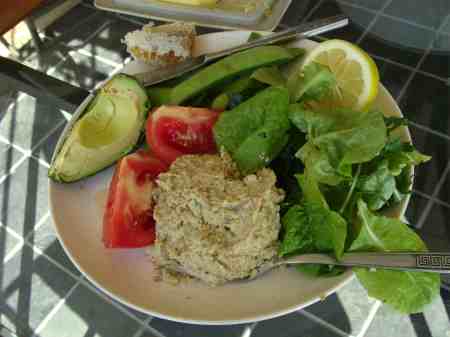
This page was last updated by Bernard Preston on 18th May, 2019.
Foods to reduce inflammation is an important subject for the chiropractor too.
Admitting that he and his colleagues have unwittingly led the public astray, he makes the decision to acknowledge and undo the wrongs of what for a quarter of a century they have advocated.
- Seriously lowered dietary fat,
- A change from animal fat to polyunsaturated oils, and
- The use of statin drugs to reduce cholesterol.

Yet blood vessels are getting ever redder, and more inflamed, despite this fixed, false belief that animal fat alone is at the crux of heart disease.
Medicine's considered opinion was that high cholesterol was the cause of heart disease. He now has a quite different opinion; foods that cause inflammation, and those that will reduce it.
Cigarettes of course have a huge role to play in inflammation of the intima; but smoking has dropped from nearly a half of all adults to around 17%, so that is not the cause of massively increased cardiovascular disease.
But this regimen of low animal fat and statins was simply not working; science, he now says, is pointing to inflammation within blood vessels rather than just a blockage from cholesterol plaque, and it's time to take a whole new approach to heart disease.
Red blood vessels are a sign of disease, and it simply cannot all be laid at the door of cholesterol. After all our forefathers lived on diets high in animal fat and did not drop dead of heart illnesses like we are. In fact, cardiovascular problems were almost unknown a century ago.
Worse, he says these long established dietary recommendations to change from animal fats to polyunsaturates have directly caused the diabetes and obesity that have totally undermined Western wellbeing. The cost in dollar terms is astronomical, he admits.
Says he, far more people on the Western diet of lowered dietary fat and the use of cholesterol-lowering medicine are dying every year of heart disease.
The American heart association admits that one in four now have cardiac disease, and that fully a quarter either have full-blown diabetes mellitus, or are well on the way. Worse, these are no longer primarily illnesses of the older person; children are increasingly being affected too.
It is the inflammatory foods that we now consume that makes our blood vessels red and angry; and only then, after the fact, is cholesterol laid down in the intima.
Without these
inflammatory foods, the cholesterol would course normally through our
arteries without being deposited in the walls.
Foods that cause inflammation
Foods that cause inflammation should be avoided at all cost if we want to live long in the land, and a life without medication.
Find the links to those topics highlighted in bold by copying and pasting into the Site Search function in the navigation bar above.
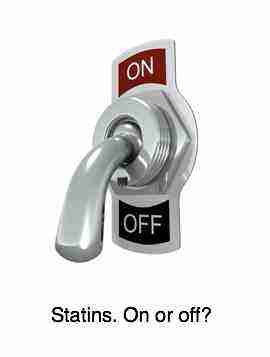
Statins erectile dysfunction
Statins erectile dysfunction is increasingly as common as are tingling legs; over two-thirds of men at age 70[5]. These may be side effects of meds you are taking.
Is your circulation red and angry?
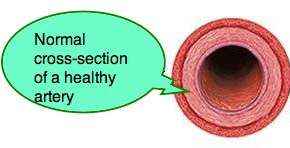
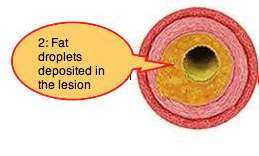
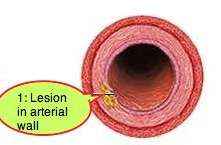
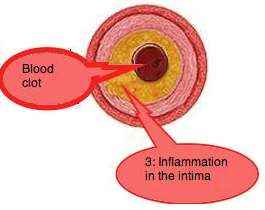
The process of inflammation of our circulatory system is not rocket-science. It is well understood. Toxic substances in our environment, be it from viruses or bacteria, or from the foods that our supermarkets now dish up, and cigarette smoke, are causing our bodies to become red, angry and painful.
Loaded with sugar, polyunsaturated fats and refined white cake-flour, our bodies are simply unable to cope, and inflammation and pain are the result. Preservatives, emulsifiers and flavourants are being fingered too; foreign chemicals.
How is that we routinely eat this junk? It is because the food science industry lays it in front of us, and Medicine has underscored it, by recommending a change from animal fat to PUFAs and more carbohydrates.
Natural unprocessed-starches are difficult to get so in effect they have unwittingly pushed into the arms of food companies producing highly refined carbs. Corn on the cob and brown rice are the exceptions.
White bread rolls, margarine, and puddings loaded with sugar are now considered our heritage foods; is it any wonder that both Americans and South Africans are rapidly becoming very sickly, obese nations? Carbohydrates like bagels and koeksusters, deep-fried in polyunsaturated oils have led us down the garden path.
Hydrogenated foods[1] tells how liquid oils are turned into solid fats, to our serious detriment.
Dr Lundell repeats it, in case we have not got the message: It is the recommendations of medicine, the seriously lowered fat in our diets, and smoking, of course, that have caused our arteries to become so inflamed and angry; diseased.
Crap diet and a smoker? Game, set and match. On average, thirteen years of your life will be lost.
What are the biggest culprits of this chronic inflammation?
- The refined starches that are in all our foods; for example, white bread, sugar, and high-fructose corn syrup.
- Then there are others like refined rice and pasta and colas and teas loaded with sugar or chemical sweeteners.
- Our foods are loaded with the omega-6 vegetable oils like soybean, corn and sunflower that are found in all the processed starches that adorn our supermarket shelves; many are deep fried.
- The way in which foods are processed changes the way in which they are digested. For example, natural honey has a low GI, but once heated the glycemic-index rises dramatically and it becomes inflammatory.
In short, it is an extremely complex process that even experts don't fully understand.
Dr Lundell makes an analogy: he says the inside of arteries, red and inflamed, look like our skin would appear if we scrubbed it every day with a wire brush.
In the same way, he says, the inside of our blood vessels become red and inflamed after being continuously exposed to these toxic foods that the supermarkets dish up.
Chocolate cakes and cookies, colas and deep fried food may taste delicious but the end result is inflamed joints, muscles and blood vessels; and our organs too. Pain, disability and death are the result; literally. It's happening all around us.
Why does enjoying a sweet doughnut make you ill?
It starts a series of chemical processes in the body, each one dependent on the previous stage, and having an add-on effect.
Firstly, your doughnut is virtually devoid of the vitamins that are found in whole foods. In preparing the flour, all the fat, including the vitamin E, a natural anti-oxidant which also prevents clot formation, is removed to improve the shelf life. Likewise the B complex vitamins that are so vital in many chemical processes in the body have been removed.
You will find the thiamine story about vitamin B1 at generalised muscle weakness[4].
Secondly, both white flour and sugar have a very high Glycemic Index; you can read more about GI at carbohydrate count chart. This results in a sudden rise of blood glucose as the starch is digested in the small intestine.
A cascade of chemical reactions begin, starting with a strong demand for a hormone called insulin that controls blood glucose levels.
If glucose gets too high, or too low, we go into a coma. The glucose is absorbed by the cells where it is stored as adipose, lowering blood sugar once more.
But if
there is too much sugar, and the pancreas cannot cope, blood glucose rises dramatically,
attaching to various proteins, and forming a toxic complex that when
repeated many times a day sets up inflammation in the body, starting
with the blood vessels which take on an angry, red appearance. The topic of foods to reduce inflammation is not just a passing fad; it is a matter of life or death.
Thirdly, your doughnut is not only made from nutrient deficient flour and sugar that damages the blood vessels, but also the fat used is from a substance named a PUFA. Polyunsaturated fats are not inherently bad, in fact some essential fatty acids are PUFAs, but it raises the ratio of omega-6 /omega-3 (ω6/ω3).
This ratio should be less than 5 but in the current Western diet, dangerously high in omega-6 and low in omega-3, it is often very high, above 20 and even 50 in some, which is strongly inflammatory.
Limiting omega-6, by changing from corn and sunflower oil to that from the olive for example, and raising the 3 is vital to reduce this inflammatory ratio.
Anti inflammatory omega 3 tells the story more fully.
When the omega ratio gets too high, cells in the body start to produce pro-inflammatory substances called cytokines. The result is angry, inflamed and red blood vessels.
I hope you are becoming convinced of the need to evaluate your diet and discover more about foods to reduce inflammation.
Shelf life
Anti-inflammatory
omega-3 fatty acids are found in fish, walnuts and flaxseeds, for
example; they are oxidised (go rancid) very quickly. Much faster than
omega-6 fatty acid foods. So processed foods are
manufactured with omega-6 oils for longer shelf life. And the omega-3
oils are removed where possible, further increasing the toxic ω6/ω3
ratio.
Omega-6 fatty acids
are essential - some like linoleic acid are "essential" - forming a part of cell membranes which control what
goes in and out of every cell; but they must be in the correct ratio with
omega-3 fats in the diet.
If the balance shifts by eating too much omega-6 rich foods, then the
cell membranes form inflammatory chemicals called cytokines that are a
major cause of chronic inflammation.
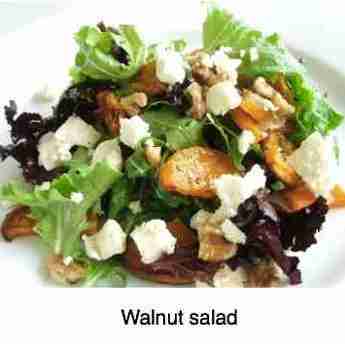
PS. I no longer use crackers in any of my salads since reading Dr Lundell's lecture; in fact our homemade low GI bread tastes much nicer, anyway. They are loaded with polyunsaturates and hydrogenated fats, and highly glycemic carbohydrate that raise blood glucose unnecessarily.
Preston aside: To reduce the omega-6 / omega-3 ratio in the diet, two things are necessary:
- Reduce omega-6 dietary fat by substituting corn oil, sunflower oil, soyabean oil (all high in omega-6 PUFAs) with olive oil (low in polyunsaturates, high in monounsaturated fatty acids).
- Increase the omega-3 dietary fat by eating more fatty, cold water fish like salmon, herring and mackerel, walnuts and a TBSP of freshly ground flaxseed daily.
Foods to Reduce Inflammation
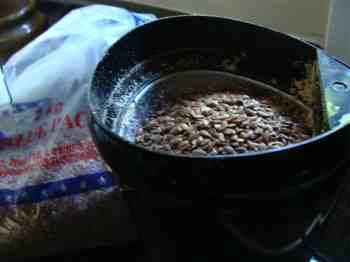
Fourthly, there's interesting research that shows that fat cells in the body themselves secrete inflammatory substances. So, the extra weight that comes from eating your white flour and vitamin deficient, sugary, polyunsaturated fat do-nut adds insult to injury; painful joints and muscles, and adipose-induced inflammation.
The net result is a painful cycle of pain, hypertension, DM, diseased blood vessels and cardiovascular illness.
It is not rocket science, and it is not fake news. Every step of this inflammatory process is now well established in the literature.
So, are you simply a bit overweight, rather fat or morbidly obese? Do you actually care? In many ways it is a spiritual issue; do we actually believe that our bodies are the temple of God? That is basic Christian belief; I am uncertain of other religions.
These highly refined foods are probably also a major cause of the chronic inflammatory process in other organs like the spinal joints, the liver, kidney, stomach and colon too.
Could coeliac disease be in part a reaction of the body to the high omega-6 fat content of cooking oil?
Normally, chronic inflammatory bowel disease is associated with a gluten intolerance, the protein in bread.
Cutting out wheat products not only eliminates the gluten, but also addresses the high omega-6/ omega-3 ratio in many flour products.
There is a serious downside of this to be considered. From ancient times, wheat has been the main source of lignans in the diet; they are a vitally important factor in the fight against malignant breast tumours. Eating whole grains, despite the gluten is strongly associated with greater wellness.
To reduce this inflammatory process in our blood vessels, joints and organs, we need to make a determined effort to:
- Greatly reduce polyunsaturated oils like sunflower (40% PUFA), corn oil (55%), soybean oil (58%); change to olive oil (11%), and even limited animal fats like butter (2%).
- Avoid "corn-fed" beef for the same reason.
- Avoid foods high in simple sugars. Raw honey may be an exception because of the pollen granules.
- Recognise that fruit juices like OJ too have a very high Glycemic Index. Orange juice facts ...
- Refined white flour breads, cookies, chocolate cake, bread rolls and donuts should be reserved for high and holy days. Rather Panera bread menu recipes.
- Make sure you are eating your "five colours" each day. Lettuce, butternut, beetroot, green beans, broccoli, berries... preferably aim for ten or fifteen; it's not difficult.
- Hydrogenated foods
- Olive oil benefits ....
- Growing lettuce ....
- Beetroot constipation ...
- Cooking green beans ...
- How to grow broccoli ...
Foods to reduce inflammation
Foods to reduce inflammation validates everything we have been saying about slow lunches made fast.
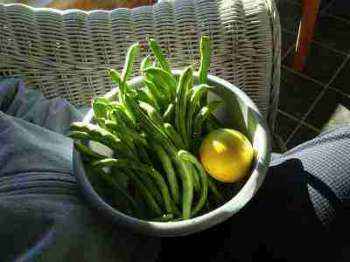
How frequently we feast on fast foods, eat out, the more we tip our bodies into the chronic inflammation trap. They simply cannot deal with nor were they designed to consume the processed meals and refined flour, loaded with sugar and polyunsaturated ω6 fatty acids.
If anything, it is homocysteine, not cholesterol that is the real villain of the peace. That is the toxic breakdown product of protein metabolism; a buildup is caused by a dietary deficiency of certain vitamins and minerals required for its degradation.
One of the benefits of limes is their proven ability to reduce the inflammation in rheumatoid arthritis and the glutamate toxicity that causes the nasty neurodegenerative diseases.
Medicine's cholesterol theory led directly to the pro inflammatory foods that now proliferate supermarket shelves. The change to a very low fat diet and cholesterol lowering statin drugs may be the very cause of the worsening epidemic of diabetes, hypertension and heart disease.
Researchers have strong evidence about heart, stroke and diabetes[1]; they are all interconnected.
It's a double hit if you are eating out a lot, and not getting those foods that reduce inflammation.
Newsletter
Our newsletter is entitled "create a cyan zone" at your home, preserving both yourself and Mother Earth for future generations; and your family too, of course. We promise not to spam you with daily emails promoting various products. You may get an occasional nudge to buy one of my books.
Here are the back issues.
- Investing in long-term health
- Diseases from plastic exposure
- Intensive lifestyle management for obesity has limited value
- A world largely devoid of Parkinson's Disease
- The impact of friendly bacteria in the tum on the prevention of cancer
- There's a hole in the bucket
- Everyone is talking about weight loss drugs
- Pull the sweet tooth
- If you suffer from heartburn plant a susu
- Refined maize meal and stunting
- Should agriculture and industry get priority for water and electricity?
- Nature is calling
- Mill your own flour
- Bake your own sourdough bread
- Microplastics from our water
- Alternative types of water storage
- Wear your clothes out
- Comfort foods
- Create a bee-friendly environment
- Go to bed slightly hungry
- Keep bees
- Blue zone folk are religious
- Reduce plastic waste
- Family is important
- What can go in compost?
- Grow broad beans for longevity
- Harvest and store sunshine
- Blue zone exercise
- Harvest and store your rainwater
- Create a cyan zone at your home
Find the links to those topics highlighted in bold by copying and pasting into the Site Search function in the navigation bar on your left.
"Mainstream medicine made a terrible mistake when it advised people to avoid saturated fat in favor of foods high in omega-6 fats. We now have an epidemic of arterial inflammation leading to heart disease and other silent killers."
Dr Dwight Lundell, cardiac surgeon.
What should we do?
Return to the whole foods our grandmothers prepared and not
those manufactured foods that our mothers served, is Dr Lundell's recommendation; you will find that they are mostly listed amongst the foods to reduce inflammation.
And especially a return to fruit, salads and vegetables which contain the vital nutrients so deficient in today's Western and South African diet.
Add smoking to that diet, and you have a catastrophe of chronic inflammation of blood vessels.
(With thanks to Signs of the Times)
Banting Diet
Into all this confusion about fats and foods to reduce inflammation comes renewed interest in a very old diet to tackle morbid obesity. First prescribed more than one hundred and fifty years ago by revered medical doctor William Harvey, the Banting diet proponents claim that it is carbohydrate, particularly in its refined form that raises blood cholesterol and causes diabetes.
The diet, with unlimited animal fat, but zero carbohydrate is stirring in the world's kitchens. It is not without controversy avoiding many of the foods to reduce inflammation because of their starch content; I prefer our modified Banting[3] way of eating.
Foods to reduce inflammation
Here is a short summary of the foods to reduce inflammation.
- Switch from omega-6 rich seeds oils like corn oil to olive oil. A few facts and figures from Olive Garden nutrition ...
- Greatly, many fold, increase the omega-3 rich oils in your diet, particularly from fatty fish, avocado, freshly ground flaxseeds and walnuts. Walnuts blood pressure ...
- Canola oil remains controversial; it is rich in omega-3 but has other toxic ingredients. Authorities remain divided at this stage; fatty fish and freshly ground flaxseeds are a better option.
- Foods rich in folate and B12 to keep your toxic homocysteine levels down. Homocysteine cardiovascular ...
- Bake your own bread using butter instead of polys for oil. Panera bread menu recipe ... a cinch with a bread machine, using stone ground whole brown flour.
- Raw honey for sweetening. Support you local beekeeper or find out how to start beekeeping ...
- Five coloured foods per day, minimum. Aim for ten. What are phytosterols? It is the flavonoids like quercetin in the onion family, and others like kaempferol that reduce inflammation.
- Enjoy far more salads and fruit on a daily basis in your bid to get more foods to reduce inflammation.
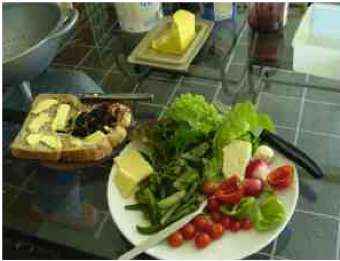
- 4 different lettuces
- Arugula, aka rocket
- Red and green peppadews
- Radish
- Green bean salad
- Cherry tomatoes
- Sprig parsley
- Mint
- Cheese
- Homemade bread, butter and mulberry jam
No apologies for the single teaspoon of sugar in the homemade mulberry jam. Butter, of course, is back. These are in good measure the foods to reduce inflammation; add a helping of salmon, and you are home and dry.
Easy lunch recipes
Easy lunch recipes enable you to avoid the highly inflammatory fast foods eaten by so many today; taking perhaps five to ten-minutes to prepare your own lunchbox should contain many of your new beneficial treats.
Making your own lunch need not take long or be a chore.
A few thoughts from our Easy Lunch Recipes come from Slow Meals, Made Fast menus. Take-away snacks are expensive and loaded with all the wrong ingredients. Choose rather from these foods to reduce inflammation.
A serious danger
Whilst I would encourage you to slowly bit by mouthful to move to nutritious living, or face the consequences, do beware of becoming a epicure neurotic; it is better to enjoy the occasional junk-food, rather than become antisocial by going totally overboard with your new lifestyle. It happens, more frequently than I care to admit.
Useful links
- Nutrition of arugula
- Go from Foods to Reduce Inflammation to our page of nutritious choice foods.
Whilst I personally go totally along with the recommendations of Dr Lundell, his personal and professional life has not been without some serious hiccups. Investing in a crazy scheme, he went bankrupt, became a tax-evader apparently, and failed to make proper professional notes after surgical cases. To the extent that hospital privileges were reportedly withdrawn.
Bernard Preston
Bernard Preston is a semi-retired DC intensely interested in the effect of good living on the spine; that means foods to reduce inflammation.
- Heart, stroke and diabetes. Web: https://tinyurl.com/4x3k9yc7
- Bone damaging inflammation
- Modified Banting diet. Web: https://tinyurl.com/2p85hj56
- Generalised muscle weakness. Web: https://tinyurl.com/2v9eeym2
- Erectile dysfunction
When browsing use right click and "Open Link in New Tab" or you may get a bad gateway signal.
Did you find this page interesting? How about forwarding it to a friend, or book and food junkie? Better still, a social mead tick would help.
- Bernard Preston homepage
- Arteries
- Foods to Reduce Inflammation
Address:
56 Groenekloof Rd,
Hilton, KZN
South Africa
Website:
https://www.bernard-preston.com